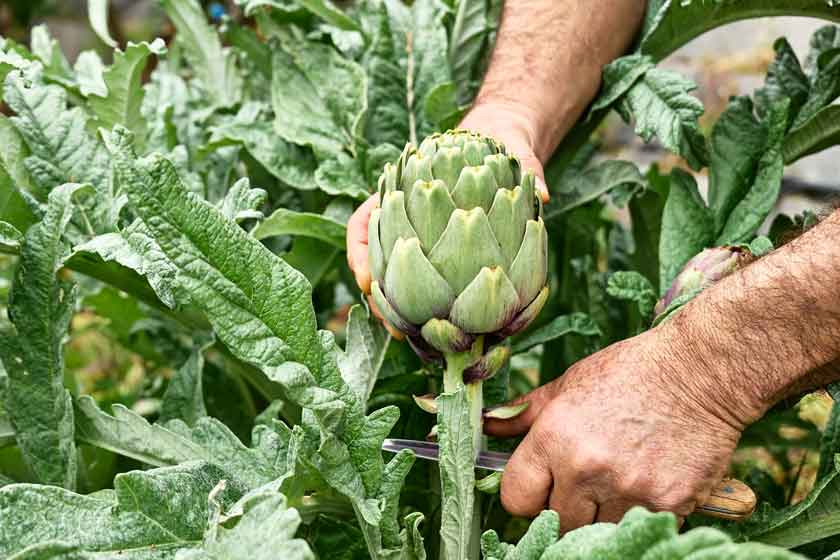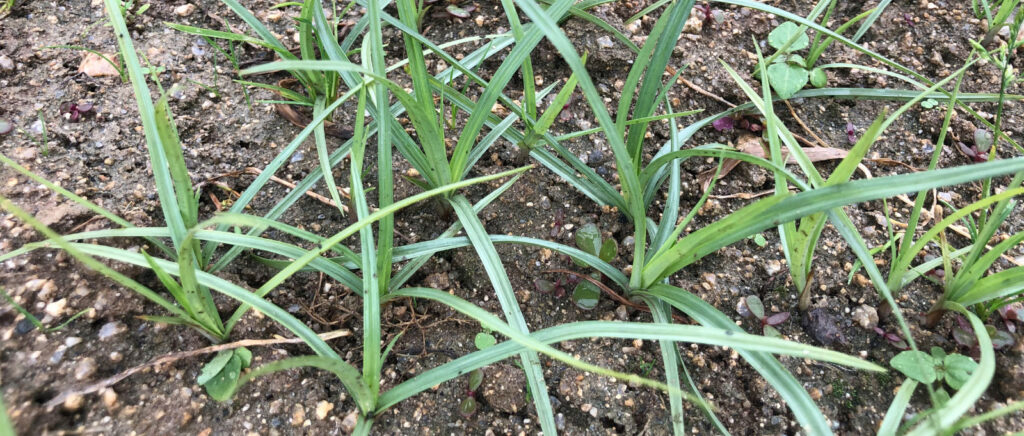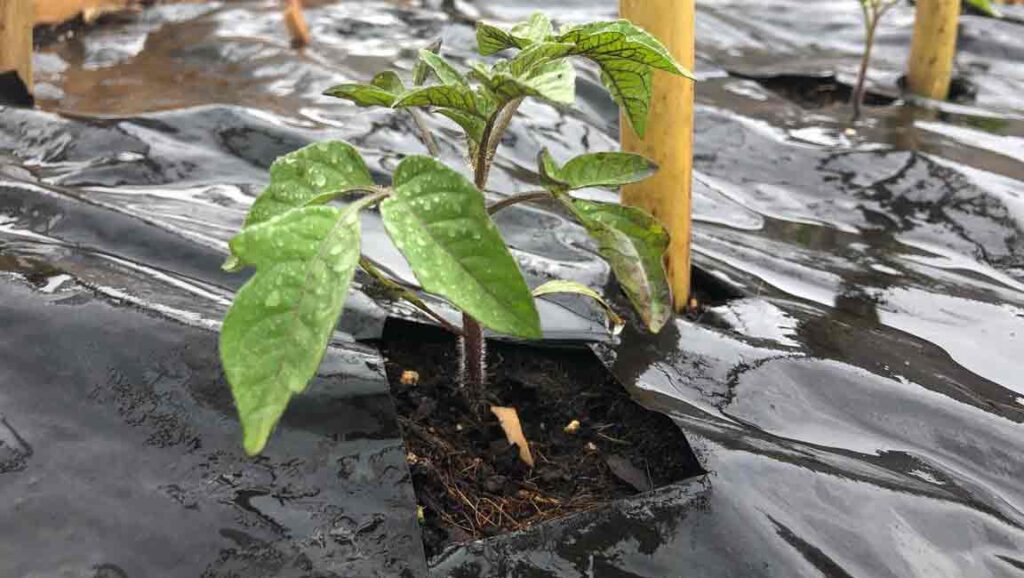This ancient, resilient plant, perfectly compatible with sustainable agricultural techniques, is a green treasure well-suited to productive cultivation for several years. In our Novamulch agricultural space, we’ll learn how to grow artichokes, from the different environments in which we can plant seeds and transplant seedlings, to the appropriate harvesting and storage times for these wonderful fruits. We now turn to the ancestral origins of our artichokes.
So, once again, welcome to our Novamulch agricultural space.
Historical background and ancestral origin of artichoke cultivation.
The Mediterranean basin is the original birthplace of “Cynara scolymus”, the artichoke. It is also known as Alcachofera (artichoke), Morrilla (artichoke), Cardo edible (in Spain), Alcaucil (used in Argentina, Uruguay and some areas of Chile), Carxofa (official name in the PDO Carxofa de Benicarló), Carciofo (Italy), Artichaut (widely used in gastronomy and agriculture), Artichoke (United Kingdom and United States of America), among many other meanings, all of them coming from the Andalusian Arabic “al-karsūfa”, the root of the modern “alcachofa” (artichoke).
However, the first records that history brings us date back to the ancient Egyptian, Greek and Roman cultures, since the “Wild Thistle” was already known and was very likely used for medicinal and culinary purposes, and these cultures began experimental cultivation to obtain different varieties until achieving what we know today as “artichoke.”
The Roman naturalist Pliny the Elder refers to a plant with the same characteristics as the artichoke, highlighting its culinary and medicinal value in his work “Naturalis Historia.” It is very likely that by then, improved varieties were already being produced in the southern regions of Italy and Sicily.
Middle Ages:
The agricultural legacy left by cultural exchange between civilizations and the development of horticultural practices inherited from Antiquity, in addition to the artichoke cultivation at that time throughout the vast Mediterranean region, were interwoven in the Middle Ages to achieve the establishment and diversification of this plant, both in southern Europe and North Africa.
Between the 7th and 15th centuries, medieval Islamic culture, in the context of al-Andalus, the Maghreb and the Near East, evolved the cultivation and variety of artichoke species, and achieved a rational agricultural practice adapted to the semi-arid climate.
Let’s study these contributions:
- He introduced improved artichoke cultivation to the Iberian Peninsula (al-Andalus), Sicily and other regions of southern Europe.
- Implement cultivation practices with irrigation, crop rotation, and use of vegetable compost.
- They left their mark by detailing the digestive and diuretic benefits in Arabic medical documents such as Avicenna’s treatises.
In medieval Christian Europe, while artichoke cultivation spread to the northern regions, Benedictine and Cistercian monasteries established in Italian, French, and Catalan territories worked in gardens for medicinal and culinary purposes. Growing artichokes and obtaining different varieties was a very common agricultural activity, appreciated for its many benefits.
During the 12th and 15th centuries, artichoke cultivation became established, and noble gardens were added to the practice. In medieval castle gardens, it began to be valued not only for its exotic flavor but also as a symbol of aesthetics and social status.
On the other hand, traditional agricultural practices and knowledge transmitted orally or through agricultural manuscripts provide us with traces such as the following:
Artichokes were planted from suckers or root division, a technique inherited from Rome and improved by the Arabs.
The nutrients used to enrich the soil consisted of organic plant matter and pruning remains or manure, mainly in noble or monasteries’ orchards.
Irrigation systems were established using canals and ditches, especially in regions influenced by Andalusian or Moorish culture, and it was common to associate the main crop with other Mediterranean species such as fennel, onions, legumes, and aromatic plants.
We will review the most important regions for the cultivation of artichokes during the 15th and 16th centuries:
Italy: It became one of the main cultivation centers, particularly in the south and in Florence, where the most fleshy varieties were improved.
Spain: The Kingdom of Aragon, the Levantine region (Valencia, Murcia) and Andalusia became benchmarks for artichoke cultivation, continuing the tradition inherited from al-Andalus.
France: The artichoke was officially introduced to the French court in the 16th century, especially under the influence of Catherine de Medici.
Netherlands and Flanders: Its cultivation began to be appreciated in aristocratic and botanical gardens for its structural beauty and flavor.
The cultivation of artichokes, along with olives, grapes, wheat, garlic, and various legumes, was introduced to America with the arrival of European colonizers in the 16th century. This arrival is known as the Columbian Exchange, which produced a momentous change in the agriculture, landscape, and culinary routines of this era.
Today, the artichoke is a highly valued agricultural crop for its exquisite flavor, culinary versatility, and health benefits. It is highly valued in local markets, supermarkets, and gourmet stores for haute cuisine dishes, presented in preserved hearts, frozen, in oil, or as prepared ingredients.
Agronomic characteristics that we need to know to grow artichokes.
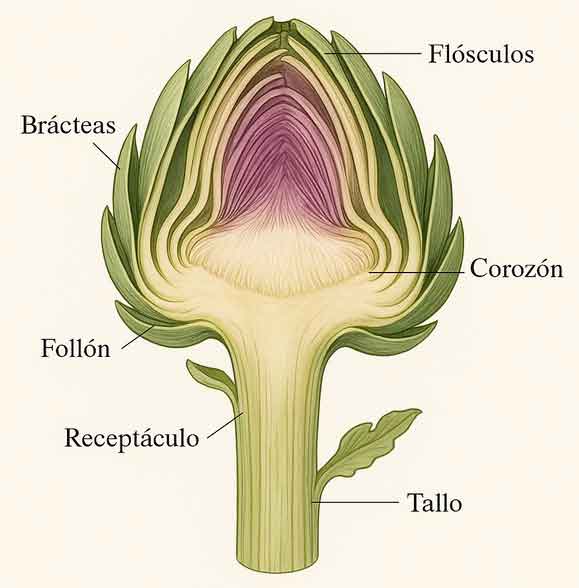
Once we’ve made the decision to grow artichokes, we should create a plan using a farming roadmap to have a complete picture of what our beautiful crop will be like, and at the same time, we’ll take advance notes on all the events that will occur: both planned and unplanned.
One of these important points is to have sufficient knowledge about the agronomic behavior of this perennial plant. A member of the Asteraceae family, artichokes are highly prized for their edible inflorescences. These inflorescences are flowers arranged in clusters along a common axis, and are the usable and edible parts of these plants, in their young, tender, and nutrient-rich stage, which we harvest before they fully bloom.
They are usually steamed, boiled, grilled, and sometimes raw, and they adapt very easily to organic and traditional horticultural operations.
Let’s not miss this video:
Let’s analyze the general morphology of artichokes.
Root system:
The artichoke has strong, deep, downward-growing roots, through which it is able to obtain water and nutrients from deeper layers of the soil, making it a resilient plant during periods of insufficient water.
Stem:
It is robust, vertical, branching at the top and can produce several flowers or inflorescences per stem.
Leaves:
Large with irregular or jagged edges, green with grayish tones.
Covered by very fine hair that allows them to retain water, thus reducing water loss through perspiration.
Let’s see in this video the benefits of artichoke leaves:
https://www.youtube.com/watch?v=FYWFifXASWU
Inflorescence:
This is the edible part in its early stages of development. Its fleshy bracts or scales are attached to the thick base of the flower, which is also edible. Its commercial quality increases if we achieve a medium to large thickness and size.
Growing cycle:
Despite being perennial, artichokes are generally grown for two or three seasons, depending on the variety selected and the type of planting.
Initial or vegetative phase:
Once we have planted the seeds, plugs (shoots from other plants), or seedlings,
the first leaves begin to appear at the base of the stem, and the root system begins to grow.
Flower induction: Artichokes begin to form stems and flowers at the end of a period of cold weather or specific pruning. This marks the end of the vegetative phase and the production phase.
The productive stage of artichokes: the flowers emerge in stages; first, we see the central part, which will be larger, followed by the secondary and smaller parts.
Propagation and multiplication: We can propagate them by cuttings or suckers, which is the most traditional method, using the most vigorous shoots from healthy mother plants. This results in uniformity and early development.
Another method of propagation and multiplication is by seed, widely used to cultivate high-yielding hybrid varieties, and in high demand for large-scale farms for commercial purposes and export.
Growing artichokes can be a very beneficial agricultural practice because they are relatively resistant to adverse conditions such as moderately saline soils, as long as they have good drainage capacity.
Furthermore, it tolerates annual pruning quite well, which allows for its vegetative renewal, and its good capacity for regrowth after harvesting will allow us to carry out several campaigns (a period that covers from land preparation to the final phase, which is the harvesting of the flower heads, in the case of our artichokes). This concept is essential for organizing tasks, planning harvests, controlling yields, and technically and commercially monitoring production).
What varieties can we choose to grow artichokes?
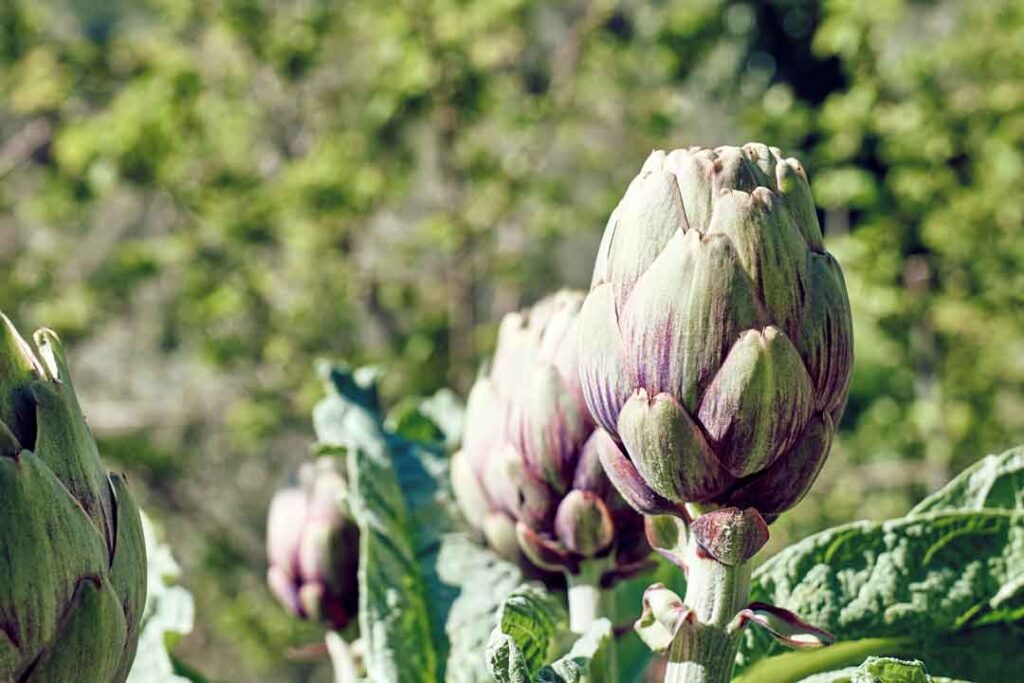
Here we find a large family, as an example of the ancestral imprint this crop has left on us since ancient times. We can classify it based on various criteria. Let’s study.
Varieties of artichokes with thorns.
These varieties have sharp appendages at the tips of their bracts, a natural defense against herbivores and adverse environmental conditions, so they must be handled and cleaned carefully. They are highly valued for their intense, slightly bitter, and persistent flavor, firm texture, and gourmet quality, making them popular in organic markets. They are mostly cultivated in various areas of the western Mediterranean, have an elongated, conical shape, and are highly resistant to cold and pest infestation.
Here we show the varieties of artichoke with thorns.
Spinoso Sardo (Italy).
Origin: Sardinia (Italy), with Protected Designation of Origin.
Characteristics:
Conical, compact, medium-sized flower heads.
Green bracts with violet hues and prominent spines at the tips.
Delicate, highly aromatic flavor with good persistence.
Cultivation: Traditionally dryland (no artificial irrigation used, relying exclusively on rainwater), and tolerates poor and dry soils well.
Palermo stickleback (Italy).
Origin: Sicily.
Characteristics:
Elongated shape, long, stiff spines.
Firm flesh, stronger flavor than spineless varieties.
Cultivation: Used both in local production and for export to northern Italy.
White Ligurian Spina (Italy).
Origin: Liguria region.
Characteristics:
Lighter-colored artichoke with white or pale yellow spines.
Conical, loosely packed flower head.
Delicate flavor, well suited to traditional dishes such as torta pasqualina.
Blanca de Tudela spiny (Spain, local selection).
The Blanca de Tudela variety is known for not having prominent spines, however, there are local lines or traditional selections that have small, sharp terminal appendages on the outer bracts.
They are less aggressive than the Italian varieties, but still visible to the touch.
Provençal Spiny Artichoke (France).
Origin: Provence region (southern France).
Characteristics:
Conical shape with green bracts and golden spines.
Very aromatic, with mild bitter notes.
Culinary use: Highly prized in traditional Mediterranean recipes.
Which thornless varieties can we choose for growing artichokes?
These boneless varieties have been developed to facilitate their handling, i.e., harvesting, peeling, and preparation, and thus be able to present them to the end consumer, the fresh market, and the canning industry in a more attractive manner.
Their main characteristics are scales or bracts without sharp tips or with soft-touch endings; the flower heads are more rounded; they produce very good yields in the field and balanced culinary quality; many of these varieties are now both traditional and hybrid, and are more commercially accepted because they are easier to operate.
Let’s look at the main varieties of artichokes that are thornless.
Blanca de Tudela (Spain).
Origin: Navarra, Spain.
Characteristics:
Medium-sized, round-shaped flower heads with green bracts.
Excellent flavor, tender texture, and a very fleshy heart.
It is grown both dry and irrigated.
Commercial Importance:
It has the Protected Geographical Indication “Alcachofa de Tudela”.
Highly valued for fresh and canned consumption.
Romanesco (Italy).
Origin: Lazio Region (Rome), Italy.
Characteristics:
Large, round, greenish-violet flower heads.
Thick, very fleshy bracts.
Mild flavor, well-suited for stuffing and traditional Roman dishes such as Carciofi alla giudia.
Subvarieties: Include C3 and other lines adapted for commercial cultivation.
Calico (Hybrid. United States and Spain).
Origin: Modern hybrid, widely grown in California and adopted in Spain.
Characteristics:
Large, rounded flower heads.
Very productive plant, suitable for intensive cultivation and mechanical harvesting.
Early maturing, high yield per hectare.
Uses: High demand in the canning and frozen food industry.
Imperial Star (Hybrid).
Origin: United States of America and developed for annual seed cultivation.
Characteristics:
Uniformly sized, round-shaped flower heads.
Suitable for production in warm areas with few chilling hours.
Early and uniform flowering.
Advantage: Allows for short-cycle intensive production without the need for stubble.
Lorca (Spain).
Origin: Region of Murcia.
Characteristics:
A variety of good size and balanced flavor.
Good resistance to progressive temperature increases.
Adapted to organic and irrigated crops.
Uses: Fresh market and for export.
Green Globe Improved (International Hybrid).
Origin: Improved from the original Green Globe variety.
Characteristics:
Large, rounded flower head.
High productivity and adaptability to different climatic zones.
Widely used in the United States, Chile, and Peru.
Now let’s study a classification based on two groups according to adaptability and ease of management specifically: Rustic varieties and Early hybrid varieties.
Rustic varieties for growing artichokes.
Hardy varieties for growing artichokes. These varieties are highly resistant to adverse climatic conditions, less dependent on intensive fertilization, and easily adapt to limited agricultural resources and poor soil quality, making them well-suited to semi-arid climates and dryland farming practices.
The common characteristics of these artichoke varieties can be explained here:
- High tolerance to moderate cold and drought.
- Due to its robust structure, it has very good plant health and is resistant to soil-borne diseases.
- Vigorous regrowth capacity after pruning or harvesting.
- Stable production, although not always the most commercially valuable.
What hardy varieties can we choose to grow artichokes?
Provence Violet (France).
Origin: Southern France
Characteristics:
Elongated flower heads with narrow, violet-green bracts and spines.
Medium cycle and good secondary production.
Greater hardiness in poor soils or drought.
Prized for its slightly bitter flavor.
Uses: Dryland cultivation and gourmet export markets.
Blanca de Benicarló, also known as “Madrileña de Benicarló” or “Benicarlanda”.
Origin: Benicarló, province of Castellón (Valencian Community, coastal area).
Protection: It has the Protected Designation of Origin: Benicarló Artichoke.
Color: Light green, slightly whitish.
Shape: Large, flattened, spherical, and compact flower heads.
Bracts: Spineless.
Climate adaptation: Excellent performance in temperate and humid climates typical of the Mediterranean coast.
Cycle: Medium to late, with high productivity and excellent quality for the fresh market.
Use: Highly valued in local cuisine, ideal for whole-grain cooking and artisanal preserves.
Madrileña.
Native variety from inland areas of the Iberian Peninsula.
Highly adaptable to dry, cold winters.
Strong stem and compact flower heads.
Madrileña (a variety from the central Iberian Peninsula).
Origin: Central Spain, especially cultivated in the Community of Madrid and inland provinces such as Toledo and Segovia.
Color: Medium green, without white tones.
Shape: Smaller and somewhat less rounded flower heads than the Benicarló variety.
Bracts: Thornless.
Climate: Very resistant to dry cold and mild frosts, suitable for continental climates.
Cycle: Medium, with good hardiness and regrowth after harvest.
Use: Grown in traditional orchards and local markets in the central Iberian Peninsula.
What early hybrid varieties can we choose for growing artichokes?
They have been developed through genetic improvement programs to offer higher yields during the first year of cultivation, with uniform growth and ease of management. They are highly recommended for modern, organic, or traditional farms that require speed and efficiency.
What common characteristics identify them?
- Rapid vegetative development from the start of sowing.
- Possibility of annual cultivation (without the need for hoeing).
- Homogeneity in both the size and shape of the chapter.
- Ideal for mechanized harvesting or intensive production.
Here we present several examples of early hybrid artichokes.
Imperial Star.
Well known for its production in the first year after planting.
Green, round, thornless flower heads.
Excellent choice for organic farming with direct sowing.
Adaptable to different climates, even at medium altitudes.
Green Queen F1.
Very short-cycle hybrid, suitable for spring planting.
Uniform and firm heads, with good shelf life after harvest.
Recommended for export and fresh sale.
Madrigal F1.
Very early and productive.
Excellent cold tolerance during early development.
Adapted to inland areas and temperate-continental climates.
Camus de Bretagne (France).
Origin: Brittany, France.
Characteristics: Grayish-green color, thornless.
This variety has one of the largest flower heads on the European market.
Highly prized in Northern Europe.
Long cycle, good cold tolerance.
Requires deep, fertile soils.
Main use: fresh market and complete cooking.
Romanesco or Catanese (Italy).
Origin: Italy (Rome and Sicily region).
Characteristics: Green color with violet hues, thornless.
Large, spherical flower head, excellent for commercial presentation.
Highly productive and early.
Good suitability for the canning industry.
Advantage: Adapts well to coastal areas and temperate climates.
Green Globe (hybrid variety).
Origin: California (United States of America), European.
Characteristics: Bright green color, thornless.
Hybrid variety, ideal for large commercial farms.
Round and uniform flower heads.
Long post-harvest shelf life.
High yield per plant.
Advantage: Widely used in industrial agriculture and short-cycle crops.
Imperial Star (hybrid variety).
Origin: United States of America.
Characteristics: Light green, thornless.
Specially selected for seed propagation.
Very early flowering: flower heads ready in the first year.
Very uniform, ideal for mechanical harvesting.
Requires good agronomic management.
Recommended use: Intensive farms, organic farming with direct sowing.
Let’s watch this short video showing us an organic artichoke crop:
Climate requirements for growing artichokes.
Originally, the artichoke is a plant native to temperate climates and adapts particularly easily to the climatic conditions of the Mediterranean regions, which means that temperature is vital for excellent growth.
For example, between 15°C and 24°C is ideal for vegetative growth, while the minimum tolerance temperature is -3°C, provided the plants have reached a good level of development.
Temperatures above 30°C will cause stress, reduced flower size, and premature flowering and lower quality.
If we want our artichokes to begin their flower induction phase, we need to maintain a temperature range between 7°C and 10°C for several weeks.
Sunshine.
When growing artichokes, it’s very important to consider providing them with at least 6 to 8 hours of direct sunlight every day to promote sugar synthesis. This will improve the flavor and quality of our product.
Relative humidity of the environment.
Here we must mention the use of biodegradable paper mulch, our indispensable agricultural assistant.
While it is very important that we achieve a humidity habitat between 60% and 70%, by implementing paper mulch we free ourselves from this responsibility, since the material with which it is made consists especially of a cultivation technique that precisely controls fluctuating humidity levels, in addition to eliminating the possibility of puddles due to excessive irrigation, or on the contrary, it will prevent dryness, soil compaction and water stress from occurring in our crops.
The artichoke has a deep root system, which makes it very resistant to these conditions of water scarcity, and yet it requires a minimum of 600 to 800 mm of well-distributed annual irrigation.
Now, if we map out areas prone to excessive rainfall, we’ll encounter problems that we must anticipate in advance. This is where we’ll explore the different environments in which we can grow artichokes using drip irrigation and using biodegradable paper mulch. Let’s see.
How to grow artichokes in different environments.
The artichoke is a very versatile plant, allowing us to grow it in both large and small areas. By conducting a preliminary study and designing our roadmap to cover all stages of the cultivation process, from planting to harvest, we can guarantee optimal results and great satisfaction from the experience gained.
Let’s then study how to grow artichokes according to our spatial needs, using the appropriate techniques and taking notes in our growing journal.
Beneficial associations for growing artichokes.
We suggest reviewing some articles we’ve published in our Novamulch agricultural space, and we’ve presented them below to help you learn how to combine compatible plants and improve your production.
Plantar Espárragos. Un cultivo ancestral, sostenible y muy rentable.
Cómo plantar Calabazas con éxito en pequeñas y grandes extensiones de cultivo.
Cómo plantar lechugas. Una oportunidad estratégica y muy rentable durante todo el año.
Let’s review this video that can be very useful:
Growing artichokes in the open field.
In these environments, we have the opportunity to fully utilize large areas, improve their natural conditions, and enhance the inherent qualities of our artichokes. If we choose to apply sustainable techniques and use biodegradable paper mulch, we will surely obtain a high-quality and healthy final product, while also nourishing the soil, as the paper mulch biodegrades, becoming an excellent nutrient for future crops.
Let’s take advantage of this video too:
How do we prepare the ground to grow artichokes in the open field?
Let’s study and take notes in our crop log.
We begin by deep tilling. We plow to a depth of 30 to 40 cm to break up compacted layers and open the soil to allow for renewed aeration and improved drainage.
We remove any remaining weeds, plastic or metal debris, if any, and any stones that hinder the development of our artichokes’ root systems. Now we prepare the ground: we level the soil, check its drainage, and correct areas prone to waterlogging. We take pH measurements and prepare any necessary amendments.
At this point, we incorporate the recommended organic sources: organic matter in the form of vegetable compost, worm castings, or composted crop residue. It’s advisable to do this at least three weeks before planting begins. Remember that all of these components must be dry, loose, and well-ground.
- Mature compost improves soil structure and provides slow-release nitrogen.
- Worm castings are a vital source of beneficial microorganisms and essential nutrients.
- Fermented plant extracts such as nettle, comfrey and horsetail slurries
- They provide micronutrients and stimulate growth.
- Wood ash (untreated) is a natural source of potassium and phosphorus.
- Rock flour or natural phosphate are ecological amendments permitted in organic farming.
Remember that applications should be made in installments during the planting process, preferably as a cover crop or through irrigation water (fertigation) if diluted slurry is used.
Once these steps are completed, we should spread the biodegradable paper mulch, as it will immediately begin to do its job of balancing and controlling humidity, inhibiting the emergence and proliferation of weeds, preventing the growth of fungi, and is our greatest contributor to achieving balance in the ecosystem and microbiota of our habitat.
If our area is in regions with short winters, we should choose early artichoke varieties. For colder areas, we should plant more hardy varieties. We should also start planting during periods when extreme weather risks are minimized, mild, or more stable. We can protect young plants by implementing natural hedges or plant barriers.
Let’s analyze water management.
Installing a drip irrigation system right in the root zone will provide greater assurance of the necessary irrigation, and adding biodegradable paper mulch will make it even safer. We can also channel dry land by digging trenches or infiltration channels to allow the roots to develop strong, deep roots.
When growing artichokes in the open field, we can use two main methods: planting plugs or suckers, and sowing from seeds. We show an example of how we can obtain seeds from artichoke flowers:
Planting clogs:
This is the most traditional method. We extract shoots from healthy mother plants and place them directly in the field, between late summer and autumn. This technique allows us to achieve greater genetic homogeneity and precocity, and we only need to select good shoots, keeping them hydrated until planting.
Sowing from seed (for hybrid varieties):
We sow seeds in seedbeds and transplant when 6 to 8 true leaves appear. This technique is very appropriate for modern farms with early hybrid varieties such as Imperial Star or Green Queen F1, as it allows for initial health control and greater mechanization.
What are the recommended distances for planting artichoke seeds in open fields?
We generally place them 1.2 to 1.5 meters apart between rows, and space them 0.8 to 1 meter apart between plants. Here we can achieve a density of 10,000 to 15,000 plants per hectare.
Growing artichokes in a greenhouse.
This environment offers us many advantages. Let’s make a list and evaluate them:
Because we have a controlled microclimate, we can harvest our produce out of season and also advance or extend our production cycle. Growing artichokes in this environment gives us the opportunity to plan staggered harvests, allowing us to obtain profits and better prices in early or late markets.
Our artichokes are protected from climatic and temperature fluctuations, especially in autumn and winter. We also avoid the unexpected effects of intense and continuous rain or wind, as well as excessive exposure to sunlight in warm regions. Growing artichokes in a greenhouse allows for a uniform and guaranteed development of the entire process.
Artichokes grown in greenhouses produce more tender and uniform flower heads, more robust and productive plants, and a lower risk of contracting diseases and pests.
Generally, when we decide to grow artichokes in a greenhouse, an essential part of our roadmap is planning the drip irrigation system, which will significantly reduce our costs. Furthermore, we don’t run the risk of losing evaporation because by spreading our biodegradable paper mulch, we maintain a permanent balance of both humidity and drip irrigation. To achieve this, remember to take appropriate measurements to regulate watering times, which will be much more spaced out compared to other environments, such as open fields.
In a greenhouse, we’ll have the ability to rotate crops, optimizing the use of space in a more controlled manner, and we won’t be subject to weather-related issues. Overall, we’ll make much more efficient use of the resources we initially had.
How do we prepare the soil for growing artichokes in a greenhouse?
Once we have removed the remnants of previous crops, plant residues, we will follow the same pattern as we analyzed in the case of open-field cultivation, starting with superficial tillage to avoid disrupting the microbial structure and at the same time aerating the soil.
In any environment, it will always be necessary to add essential nutrients such as mature vegetable compost, worm castings, or composted plant-based manures to enrich the soil.
We also spread biodegradable paper mulch to prepare the essential balance of soil, substrate, humidity, and temperature required to begin planting.
If you need to incorporate fertilizers (preferably organic), we can do so in solid form before sowing or transplanting, and then dilute them during fertigation.
Let’s review in detail the main nutrients and their ecological sources.
Nitrogen (N).
Main function: leaf development and vegetative vigor.
Recommended organic source: vegetable compost, nettle slurry, legume meal.
Phosphorus (P).
Main function: root formation and flower development.
Recommended organic source: wood ash, vegetable bone meal, natural phosphate.
Potassium (K).
Main function: fruit quality and stress resistance.
Recommended organic source: comfrey extract, vegetable vinasse, rice husk ash.
Calcium and Magnesium.
Primary Function: Cellular strength and photosynthesis.
Recommended organic source: Natural dolomite, dried seaweed meal.
Micronutrients.
Primary function: overall plant health.
Recommended organic source: aerated compost tea, worm castings leachate.
Furthermore, it is advisable to take certain ventilation measures to prevent the accumulation of moisture and condensation and prevent the growth of fungi.
Keep side or skylights open. If your greenhouse is exposed to sunlight that could generate excessive heat, it’s very important to install polyshade netting at 30% or more, and use thermometers to measure temperature (15° to 25°C) and humidity (60% to 70%).
The recommended method of sowing is by seedlings (clumps), or preferably certified organic seeds. The sowing method is the most traditional. We extract healthy shoots from mother plants and first soak them in diluted garlic or horsetail extract to prevent fungus.
When sowing from seed, which is particularly suitable for early hybrid varieties like Imperial Star Eco, we will create a seedbed with organic substrate such as peat, coconut fiber, and sifted compost. We then transplant the seedlings to the growing tray when 6 to 8 true leaves have sprouted.
The appropriate planting frame will be 1.0 to 1.2 m between rows, and 0.7 to 0.8 m between plants.
Growing artichokes in pots.
Growing these artichokes is also very viable in these small environments. By observing basic requirements and care, we can obtain very good quality artichokes. Containers should be deep enough and have good drainage.
As a first step, we recommend placing a layer of volcanic rocks, broken ceramics, or expanded clay at the bottom to allow for good water circulation and a compaction-free substrate.
We must now incorporate a mixture of peat, coconut fiber, and perlite or river sand to ensure good aeration and drainage.
30% to 40% well-rotted vegetable compost to enrich the mix with organic nutrients and beneficial microorganisms.
10% as a source of active microbial life and prolonged natural fertility.
Rock flour or vegetable ash to provide essential minerals such as phosphorus and potassium naturally, in small amounts. This last component is optional.
Once all the nutrients are mixed, it’s necessary to let the soil rest for a few days before planting, allowing the substrate organisms to stabilize and the environment to activate naturally. This organic preparation ensures that our artichokes have a healthy, fertile, and sustainable environment from day one.
The container’s mobility has many advantages. It allows us to adjust the plant’s exposure to changes in sunlight throughout the year.
For example, during the active growth phase, we will place the pot in a space where it receives several hours of direct sunlight a day.
During the colder months, we can move it to more sheltered areas, such as near a sunny wall, and during periods of intense heat, we move it to a space with partial, light shade to avoid heat stress.
Now, remember that container space is limited, so it’s essential to maintain proper humidity levels. If we spread biodegradable paper mulch over the soil surface, we can ensure that moisture remains balanced throughout the planting process.
However, we’ll be careful with watering so that the water penetrates to the bottom of the pot. This means we’ll water slowly and deeply when we notice a certain dryness in the soil. In these cases, shallow and frequent watering can lead to weak roots and disease at the base of the stem.
It is highly recommended to collect rainwater in clean buckets or containers for irrigation, as well as water used to cook vegetables, cold and without added salt, and water used to wash fruits and vegetables, as long as it does not contain soap or greasy residue.
Growing artichokes in home and urban organic gardens.
By promoting these types of crops in our communities, we will provide a wonderful experience and benefits, as well as more conscious, autonomous, and regenerative collective learning.
Soil preparation isn’t very different from the rest of the environments we’ve studied, and yet we must remember that our artichokes require a habitat that encourages the development of a deep root system, and for this we prepare beds with a depth of at least 30 cm.
In these cases, we can also use homemade compost material, dry and well dissolved, such as fruit remains, dried leaves, vegetable peels, dried grass or untreated wood sawdust, and we can add a mixture of 40% coconut fiber or aerated vegetable substrate, 30% mature vegetable compost, 20% vegetable humus or leaf compost, and 10% coarse sand or perlite.
This combination ensures a light, well-draining, and highly nutritious substrate for the complete artichoke growing cycle.
Growing artichokes on terraces and balconies.
Today, growing crops in these environments has become a highly valued practice in urban agriculture. These perennial plants thrive in a wide variety of containers and containers that are spacious, deep, and have good drainage.
By reproducing a fertile and continuous ecosystem on a small scale—that is, by simulating a living ecosystem by combining organic and mineral materials that promote both water retention and the progressive nutrition of the plant—we can successfully achieve high-quality crops.
We should choose containers or planters between 35 and 40 cm deep, with good drainage capacity and sufficient diameter so that our artichokes can develop a healthy and stable root system.
We can prepare the following substrate mix at home or purchase the components individually from organic nurseries. Here’s a list:
40% aerated plant substrate composed of a mixture of coconut fiber, unfertilized plant peat or highly sieved plant compost.
30% mature vegetable compost, made from fruit scraps, dried leaves, peels, and green waste without chemical additives.
20% leaf humus or recycled forest compost, which improves the microbial life of the substrate and regulates its structure.
10% coarse sand or volcanic perlite, suitable for promoting drainage and preventing possible compaction.
We’ll also add organic fertilizers such as compost to renew the top layer of the substrate every 6–8 weeks with 2–3 cm of material.
We’ll add compost tea, an aerated infusion of compost, and apply it through irrigation every 10–15 days to stimulate the substrate’s microbiology.
Nettle slurry diluted to 10% with the irrigation water; rich in nitrogen and minerals, and appropriate for the growth phase.
Fermented comfrey extract applied every 2–3 weeks during the reproductive phase; a great source of potassium and excellent for flower head formation.
Vegetable ash provides potassium, calcium, and micronutrients. Use sparingly (1 tablespoon per plant per month), sifted, and well mixed into the substrate.
We can also add organic mineral supplements such as basalt rock flour, which slowly and steadily releases phosphorus, calcium, magnesium, and silicon. Natural dolomite is suitable for acidic soils or those deficient in calcium and magnesium. We apply it once at the beginning of the crop.
Growing artichokes in this type of environment will also require maintenance of the substrate throughout the growing season. For example, we should remove the soil surface every 3 or 4 weeks to prevent compaction, and whenever possible, we should avoid using concentrated liquid fertilizers, even organic ones, as they can disrupt the natural balance of the substrate in small containers.
Artichoke crop maintenance for any type of environment.
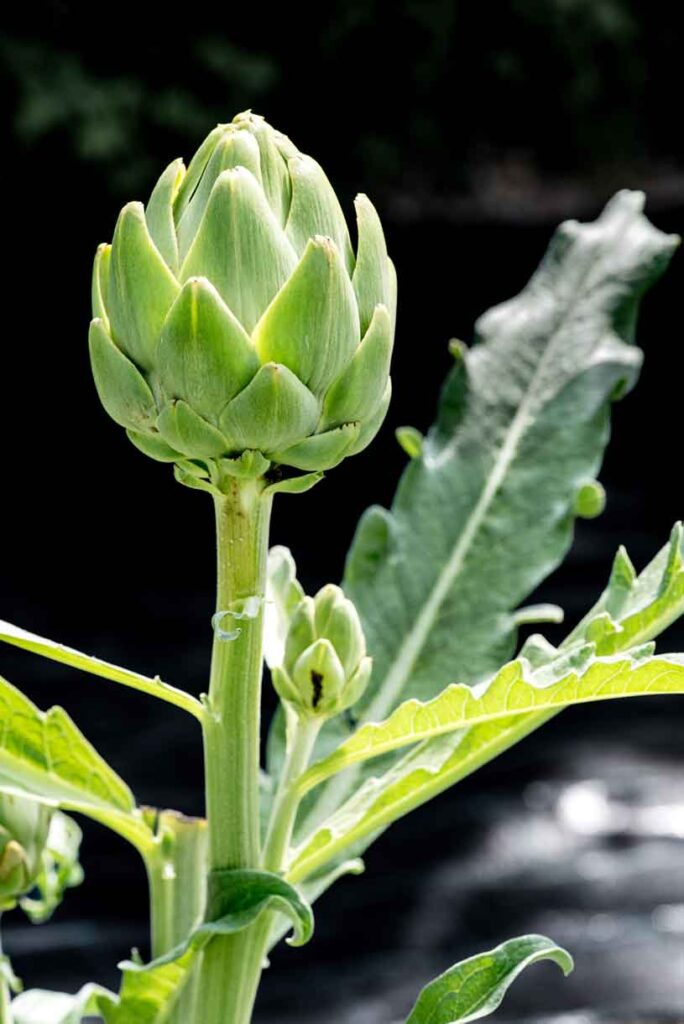
We’ve already conducted a detailed study of everything related to fertilizing these perennial plants, and now we’ll discuss the appropriate maintenance approach to supporting the natural cycles of our artichokes, strengthening their vitality through plant nutrients, and preventing imbalances by observing and caring for the surrounding ecosystem.
Manual weed control.
Especially during the first weeks of the cycle, we will manually remove all plants other than our crop that compete with and invade the soil, taking care not to alter the root system or the beneficial microorganisms in the soil.
Biodegradable paper padding.
We spread mulch before sowing or transplanting. We’ll explore this technique later.
Ecological water management.
We will water moderately when we notice that the soil has dried, making a hole 3 to 5 cm deep.
It’s very beneficial for our crops to water with rainwater, water from washing fruits and vegetables, without added salt or chemicals, and safe recycled domestic water. To this end, and to the extent possible, we should collect it in clean containers and have it on hand for when we need it.
When growing artichokes in greenhouses, pots, on terraces, and balconies, drip irrigation is a priority, as is watering with a fine-spouted watering can or clean, reusable bottles to minimize losses.
We’ll remove any weak shoots or secondary shoots that compete for resources, and retain the sturdier ones for future divisions or sprouting. To do this, we must use clean shears or do it manually and carefully to avoid damaging the plant. We also remove any dry, stained, or diseased leaves to allow for adequate ventilation and prevent the growth of fungus.
Keep our grow log up to date.
The review, measurement, continuous observation and recording in our journal or crop log, gives us guarantees on the development and progress of the stems, leaves, substrate, balanced level of nutrients, humidity and temperature, as well as signs of possible soil compaction, leaching, weakness, stress, need for water adjustments, increased fertilization, and other signs that we should attend to in time to control the balance of our crops.
Additional care.
If we live in regions with low temperatures and during the winter, we will protect the base of the artichokes with biodegradable paper mulch to maintain the appropriate temperature and humidity.
At the end of the second or third year after the initial planting, we can divide the plant and transplant the suckers to new furrows or containers. After harvesting, the latter will need a 15% to 20% renewal of the substrate, and a new extension of the biodegradable paper mulch, since the previous one has already been converted into a nutrient.
Biodegradable paper mulch as an advanced technique for growing artichokes.
Today, paper mulch is an indispensable tool for protecting and preserving all types of crops and environments, from open fields to small spaces.
Especially if we are going to grow artichokes due to their morphological characteristics and their prolonged growth cycle, as it is an ecological and sustainable practice that allows us to protect the soil and the substrates we have incorporated, optimize natural resources such as water because it stabilizes humidity and temperature levels, and is also an excellent contributor to microbial biodiversity by biodegrading and transforming into a wonderful nutrient for our future agricultural plans.
Furthermore, biodegradable paper mulch acts as a protective barrier for the soil and substrates by inhibiting the emergence and proliferation of weeds such as sedges and fungi, whose preferred breeding ground is uncontrolled moisture. (When spread on the soil, mulch prevents rain or irrigation droplets from splashing soil onto the stem and leaves, reducing the possibility of fungal or bacterial infections.)
By providing an effective means of physical defense that prevents the germination of these competing weeds, paper mulch reduces the need for manual weeding and avoids the use of polluting herbicides.
Growing artichokes requires specific consideration of the soil we are working in. As a perennial plant with a deep root system and extensive leaf development, the underlying conditions must be protected in such a way as to ensure continuous thermal and humidity balance, as well as an active biological structure from the beginning of planting to harvest.
Paper mulch controls and conserves this habitat, which is suitable for our crops. It progressively biodegrades without leaving residue or incorporating synthetic compounds. It enriches the soil with organic carbon and promotes microbial life without altering the pH. Therefore, its use is suitable for certified organic farming projects, small-scale and urban crops, and as a faithful partner for those producers seeking to minimize polluting inputs and unnecessary costs.
As one of the most valued perennial crops on the market, we recommend including biodegradable paper mulch as a natural thermal regulator in our roadmap for growing artichokes. The root system is protected from excessive heat during the summer months and from low temperatures or intense cold during the winter months.
When our growing areas are located on slopes or frequently exposed to wind, paper mulch supports the soil structure and keeps it stable, thereby protecting the entire crop system and soil microbiota.
This excellent, advanced material can remain active and in perfect condition throughout the entire growing season, and even longer, depending on its thickness and quality. As we observe its biodegradation, we can easily replace it with a new layer.
You can purchase Novamulch biodegradable paper mulch below:
-
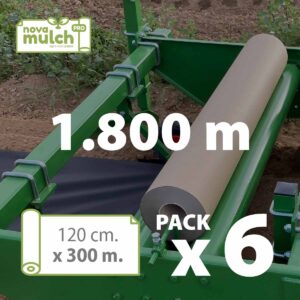 PACK of 6 rolls of Novamulch Professional paper 120 cm. x 300 m. (1.800 m)565,28 € IVA incluido
PACK of 6 rolls of Novamulch Professional paper 120 cm. x 300 m. (1.800 m)565,28 € IVA incluido -
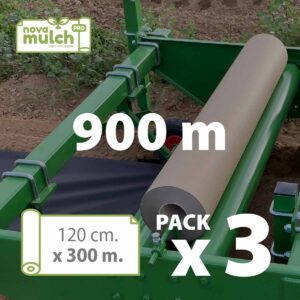 PACK of 3 rolls of Novamulch Professional paper 120 cm. x 300 m. (900 m)282,22 € IVA incluido
PACK of 3 rolls of Novamulch Professional paper 120 cm. x 300 m. (900 m)282,22 € IVA incluido -
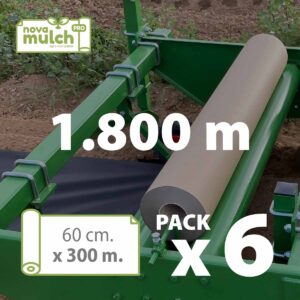 PACK of 6 rolls of Novamulch Professional paper 60 cm. x 300 m. (1.800 m)282,22 € IVA incluido
PACK of 6 rolls of Novamulch Professional paper 60 cm. x 300 m. (1.800 m)282,22 € IVA incluido -
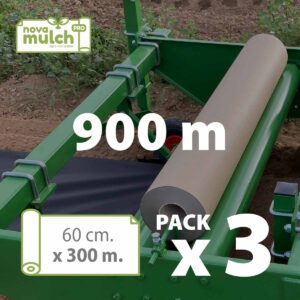 PACK of 3 rolls of Novamulch Professional paper 60 cm. x 300 m. (900 m)141,30 € IVA incluido
PACK of 3 rolls of Novamulch Professional paper 60 cm. x 300 m. (900 m)141,30 € IVA incluido -
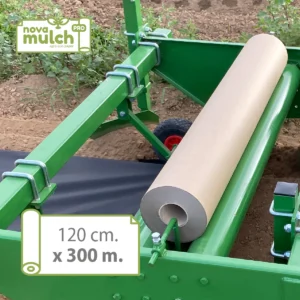 Novamulch Professional Paper 120 cm. x 300 m.94,21 € IVA incluido
Novamulch Professional Paper 120 cm. x 300 m.94,21 € IVA incluido -
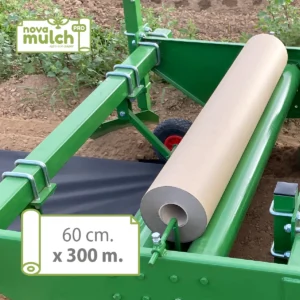 Novamulch Professional Paper 60 cm. x 300 m.47,10 € IVA incluido
Novamulch Professional Paper 60 cm. x 300 m.47,10 € IVA incluido -
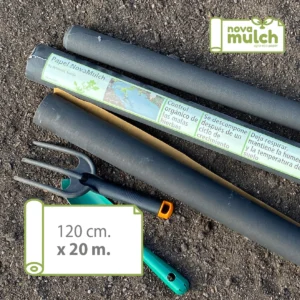 Novamulch paper 120 cm. x 20 m.41,63 € IVA incluido
Novamulch paper 120 cm. x 20 m.41,63 € IVA incluido -
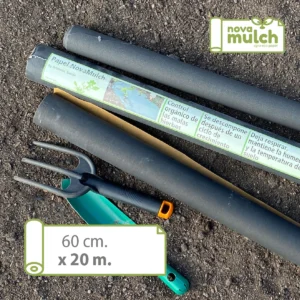 Novamulch paper 60 cm. x 20 m.21,89 € IVA incluido
Novamulch paper 60 cm. x 20 m.21,89 € IVA incluido -
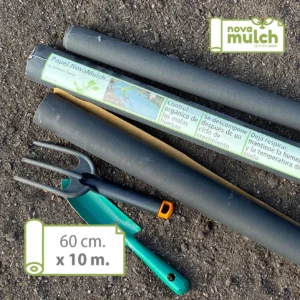 Novamulch paper 60 cm. x 10m.14,85 € IVA incluido
Novamulch paper 60 cm. x 10m.14,85 € IVA incluido -
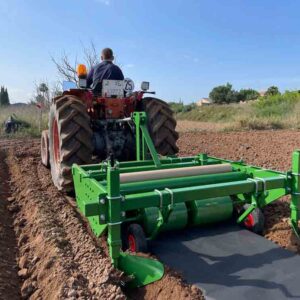 Novamulch agricultural mulching machine
Novamulch agricultural mulching machine
What are the exact times for harvesting artichokes?
These harvest times are very important as they define the quality, texture, and flavor of the final product. This varies depending on the variety of artichokes we have selected, as well as the environment in which we have planted them and the climatic conditions of our region. However, we can follow general criteria that allow us to establish the correct harvest times for this and any other cultivation system.
Remember that the timing of cutting the flower heads (edible flowers) will be crucial to achieving maximum plant yield and ensuring continued production throughout its active cycle.
We begin harvesting between 120 and 180 days after sowing or transplanting, depending on the variety. In temperate climates, and having grown varieties adapted to these climates, we can harvest in late fall and extend it into early spring.
What visual criteria are we going to follow?
Here are some tips to help you know if an artichoke is ready to be cut:
Firm and closed flower head: the clearest sign will be when we see that the flower head is closed, firm to the touch, and must have reached a height of approximately 8 to 15 cm depending on the variety, with no signs of opening in the bracts (outer leaves) or of incipient flowering.
If the artichoke begins to open or show a purple center (florets), it’s past its prime. At this stage, the texture becomes fibrous and loses commercial value.
The artichoke should be green or purple in color, with no brown spots or signs of oxidation or dehydration. When lightly pressed, the artichoke should offer resistance, not be soft or fibrous. When the stem that accompanies the flower head is tender, cut it to 5 to 10 cm in length. It should split easily with a knife or scissors and show no signs of woodiness.
The right size is when the artichokes reach a diameter between 7 and 12 cm for the most common varieties, such as Blanca de Tudela or Romanesco. Smaller artichokes, approximately 6 cm, are mostly used for canning.
Medium-sized ones, between 7 and 9 cm, and large ones, approximately 10 cm, are well-suited for fresh sale. The flower head should be between 8 and 15 cm tall, depending on the variety.
Artichokes should be harvested every two to four days because they mature in stages; first the main or central head, followed by the secondary heads. This continuous harvest extends the harvest period and maintains production for several weeks or months.
Harvesting artichokes in successive years.
Perennial crops are those in which we keep the same plant for more than one growing season or season. In these cases, the first harvest is usually later, but it will be the most vigorous.
From the second year onwards, the plant can offer several harvests per season, especially if the tillers are well managed and continuous monitoring and maintenance is carried out.
It is advisable to use clean pruning shears or a sharp knife to avoid damaging the mother plant, cut the flower head at the base of the stem, reserving a few centimeters for easier handling, and harvest during the early hours of the morning as the plant will be more hydrated and firm.
How should we properly store artichokes after harvesting?
Once harvested, artichokes require careful handling to preserve their freshness, texture, and flavor.
Because this product is highly sensitive to dehydration and oxidative deterioration, it must be stored using methods that maintain its natural properties without resorting to preservatives or artificial processes.
This is especially important in the context of organic farming, where food integrity and respect for the environment are prioritized.
How long can artichokes be stored after harvest?
Under optimal refrigeration conditions, fresh artichokes can be stored for up to 10 or 12 days. At room temperature, their shelf life is drastically reduced to 2 or 3 days, especially if no additional preservation methods are used. If you choose to process them through artisanal methods such as canning, freezing, or dehydrating, they can remain in good condition for several months.
Fresh storage of artichokes.
To keep them fresh and free from chemicals and conventional plastics, we recommend wrapping them individually in recycled or compostable paper, or in a breathable cotton cloth bag.
We’ll store it in the refrigerator, in the coolest section (between 1°C and 4°C). Since they lose water quickly through perspiration, it’s advisable to maintain a high relative humidity of between 85% and 90% in the container or compartment, and we can place a slightly damp, but not too wet, cloth near the artichokes.
Remember not to store them near fruits that emit ethylene, such as apples and bananas, to prevent the artichokes from ripening and deteriorating.
Store in a cool, shaded environment, without refrigeration.
For those who grow artichokes in rural areas or are looking to reduce energy consumption, this method is the most appropriate. In these cases, we should place them in ventilated wooden or cardboard boxes, in a single layer and without stacking them.
We will place them in a cool, dry, dark, and well-ventilated space.
We will do daily checks, and we should consume first those that show signs of softening or opening.
Long-term preservation, for organic home processing.
If we need to store our artichokes for longer, we can use natural and sustainable homemade methods, as we will see below:
Canned artichokes.
- We blanch the artichoke hearts in water with lemon juice.
- Then we place them in sterilized glass jars with a mixture of apple cider vinegar, water, and herbs, seal them tightly, and store them in a dark place for up to 6 months.
Frozen artichokes.
- We blanch the artichoke hearts for 3 to 5 minutes.
- We cool in ice water, drain well and freeze in reusable containers.
- This way we can maintain its quality for 6 to 8 months.
Dried artichokes.
- We cut the artichokes into thin slices and place them in a container with water and lemon or vinegar to prevent them from oxidizing. We dry them in the sun if we live in a dry climate, or we can also do so in a solar dehydrator, or simply in the oven.
- If we’re baking in a conventional oven, once we’ve sliced them and submerged them in the liquid, we need to drain them well and dry them with a clean cloth. We can brush them with a few drops of olive oil to enhance the aroma and prevent them from sticking.
- Preheat the oven to a temperature no higher than 90°C.
- We place the separate sheets on a tray with greaseproof paper or on a rack.
- When placing the tray in the oven, we must leave the door ajar so that the moisture can evaporate.
- Then we let them dry and cool outside the oven for 4 to 6 hours, and finally we pack them in airtight glass jars, in a cool, dry place.
- This method is particularly useful for preparing infusions or broth bases.
Common pests and diseases to consider before growing artichokes.
The artichoke is a vigorous, hardy plant that adapts to diverse environments and climates, but it also needs protection. It is not immune to pests and diseases that can cause irreversible damage to our crops.
Let’s continually monitor its development and note down every event, planned or unplanned, in our crop log to verify the measurements and developments that occur during the cycle, as well as any anomalies that may arise and that we can anticipate or resolve in a timely manner.
Let’s save this list of common artichoke pests.
Aphids (Aphis spp.).
Symptoms: They appear in colonies on tender shoots, young leaves, and flower heads. They cause leaf deformation, reduced growth, and the presence of honeydew that favors the development of fungi such as sooty mold.
Organic solutions: Nettle slurry (rich in silicon and repellent). Apply diluted at 10% in water every 5 days as a preventative or for mild infestations.
Garlic or wormwood infusion: powerful repellent. Apply by spraying directly onto the colonies.
Biological control with ladybugs (Coccinellidae): installing insect hotels or avoiding the use of pesticides encourages their natural presence.
Watering at the base: avoid wetting the aerial parts to avoid stressing and weakening the plant.
Leaf miner (Liriomyza spp.).
Symptoms: Meandering galleries on the leaves caused by larvae. Decreased photosynthetic capacity and general weakness.
Organic solutions: Neem infusion (not concentrated). Apply every 7 days during the risk stage.
Natural attractants such as yellow chromatic traps: Place them near the crop to detect and reduce adults.
Horsetail extract: Strengthens leaf tissue, making the plant less attractive for oviposition.
Crop rotation: Prevents population buildup in successive crops.
Stem borer (Carpophilus spp. and other larvae).
Symptoms: Borings in the stem or base of the plant. Sudden wilting or partial collapse. Often caused by unremoved crop debris.
Ecological solutions: Manual removal of affected stems and plant debris at the end of the cycle.
Mulch with clean, biodegradable paper to prevent access from the soil.
A concentrated infusion of natural tannins (such as pomegranate or walnut peel) applied to the stem.
Companion planting with marigold or borage, which repel soil-borne insects.
Snails and slugs.
Symptoms: Perforated leaves, especially on seedlings and young shoots. Presence of slime or shiny traces.
Ecological solutions: Physical barriers of vegetable ash, coffee grounds, or dry sawdust around the plant.
Ecological beer traps: Bury a container of natural beer to attract and control insects without harming other insects.
Manual night inspection: Especially effective on terraces and balconies.
Encourage the presence of hedgehogs, toads, and insectivorous birds in open vegetable gardens.
Artichoke fly (Terellia fuscicornis).
Symptoms: The larvae burrow into the flower heads and damage them from within.
May go unnoticed until the damage is severe.
Ecological solutions: Harvest flower heads early. Avoid leaving very mature flower heads on the plant.
Mulch with biodegradable paper to hinder the insect’s life cycle in the soil.
Visual and aromatic traps: Ecological attractants based on apple cider vinegar or fermented fruit extract.
Plant natural repellents such as basil, lavender, or sage near the crop.
Let’s now analyze the diseases specific to artichokes.
Artichokes can be affected by several pathogens, mainly fungi and bacteria, which compromise their development, productivity, and longevity.
Botrytis or gray mold (Botrytis cinerea).
Symptoms: Appearance of a grayish mold on the flower heads, leaves, or stems. Moist brown spots spread rapidly, especially in humid climates or on densely packed plants.
Ecological solutions: Proper ventilation and pruning: remove old or diseased leaves to improve air circulation.
Mulch with biodegradable paper, which keeps the base dry and prevents spores from accumulating in the soil.
Applications of horsetail extract (Equisetum arvense): a powerful natural antifungal. Dilute to 10% and spray every 7 days as a preventative measure.
Nettle infusion: strengthens the plant’s immune system.
Downy mildew (Bremia lactucae and Peronospora spp.).
Symptoms: Yellowish or grayish spots on the upper surface of the leaves. Cottony mold on the undersides of the leaves. In severe cases, premature leaf drop and general weakening may occur.
Organic solutions: Avoid excess moisture: water only at the base of the plant and maintain a well-aerated substrate.
Treatment with vegetable potassium bicarbonate: mild preventative and curative action. Mix 5g per liter of water and spray weekly.
Garlic and ginger decoction: antimicrobial properties. Apply every 5 days during active sprouts.
Crop rotation: prevents the pathogen from persisting in the soil.
Rust (Puccinia spp.).
Symptoms: Small orange or brown pustules on the underside of leaves. Loss of vigor, leaf drop, and photosynthetic deficiency.
Organic solutions: Remove infected leaves as soon as the first symptoms appear.
Preventive applications of horsetail infusion or onion decoction.
Wider planting spacing and adequate aeration.
Increase potassium in the substrate with vegetable ash, which strengthens cell walls.
Leaf spots (Alternaria spp. and Cercospora spp.).
Symptoms: Dark, circular spots with a yellow halo that expand and can cause necrosis. They occur especially on adult leaves.
Organic solutions: Comfrey slurry (Symphytum officinale): stimulates natural defenses. Apply every 10 days diluted at 15%.
Thyme or sage decoction: natural antifungal action.
Use certified, healthy seeds: important when sowing your own seeds to prevent vectors.
Collar or base rot (Sclerotinia spp. or Phytophthora spp.).
Symptoms: Yellowing of the outer leaves. Softening of the stem at the base and death of the plant. Presence of white mycelium or black sclerotia in the soil.
Ecological solutions: Good substrate selection: well-drained, loose soil.
Biodegradable paper mulch: Avoid direct contact of the stem with moist soil.
Avoid excess water and do not water above the base of the plant.
Provide beneficial microorganisms: through mature vegetable compost or homemade biofermented fertilizers that activate the soil microbiota.
What preventive strategies should we implement to grow artichokes?
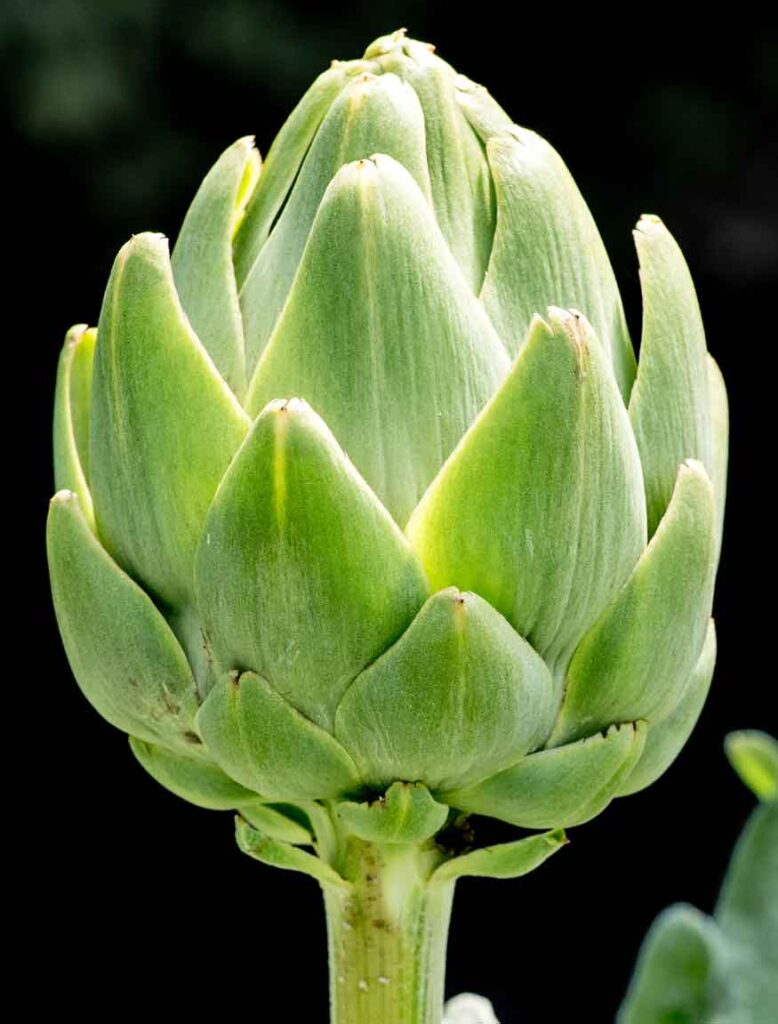
- Combine your planting with repellent plants and natural fungicides, such as marigold, chives, or nasturtium.
- Diversify and rotate crops to avoid the accumulation of specific pathogens.
- Sowing and transplanting at optimal times in the lunar calendar, if biodynamic agriculture is followed.
- Avoid the use of non-breathable plastics, which promote stagnant moisture and the growth of fungi.
Artichoke crop diseases can be effectively managed using ecological and organic techniques that respect soil life, biodiversity, and plant health.
Through infusions, vegetable slurries, preventative practices, good environmental management, and the use of biodegradable paper mulch, it is possible to keep our crops healthy without resorting to chemical inputs.
Understanding the life cycle of each disease and its natural prevention is a key tool for truly sustainable agriculture.
Final thoughts.
On this occasion, our agricultural space has taken us on a tour through the art of growing artichokes. We go back far beyond considering this agricultural practice as a common form of cultivation. We connect with this ancient, almost ritualistic tradition, with the profound wisdom of ancient civilizations, and with the intimate relationship between races, customs, and planting methods since ancient times.
The artichoke, with deep botanical and cultural roots, has adapted over time to changing climates, environments, and innovative practices, yet remains a noble, resilient, and generous crop.
We’ve now realized that, beyond yield and profitability, growing artichokes represents an opportunity to learn from the land, to apply sustainable practices, to plan responsibly, and to live a regenerative experience.
Whether in open fields, greenhouses, urban gardens, balconies or terraces, or pots, this vegetable offers us the opportunity to integrate agricultural knowledge with conscious ecological action.
At the heart of this proposal is a commitment to an agricultural model based on soil care, responsible variety selection, the use of biodegradable materials such as paper mulch, and the active protection of biodiversity.
At our Novamulch agricultural space, we believe that growing artichokes is not just a horticultural task, but a way to sow for the future.
Let’s inspire and serve as a reference point for those who decide to start or improve their artichoke cultivation from any corner, with respect for the land and passion for what flourishes from it.

